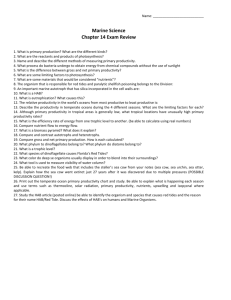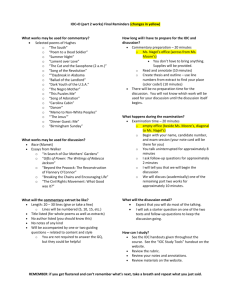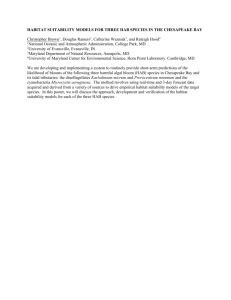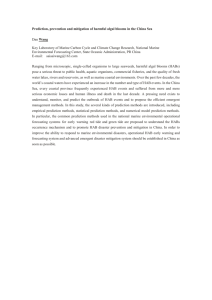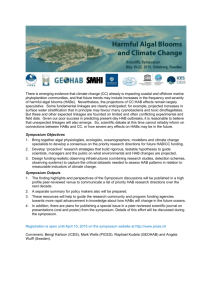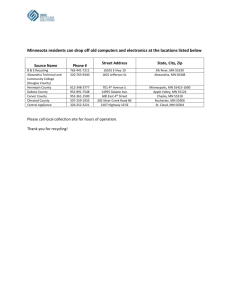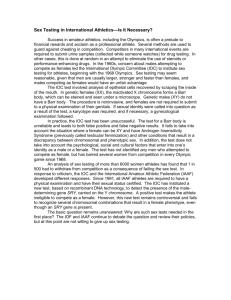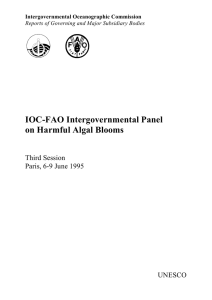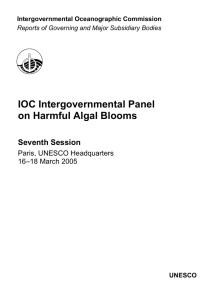15
advertisement
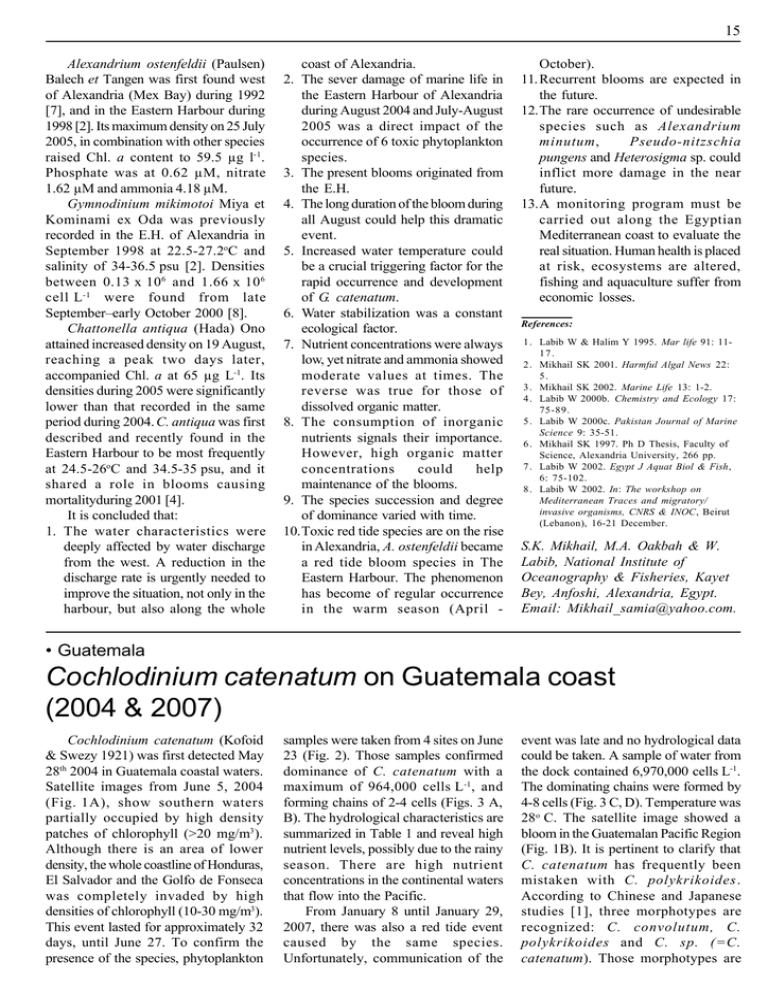
15 Alexandrium ostenfeldii (Paulsen) Balech et Tangen was first found west of Alexandria (Mex Bay) during 1992 [7], and in the Eastern Harbour during 1998 [2]. Its maximum density on 25 July 2005, in combination with other species raised Chl. a content to 59.5 µg l-1. Phosphate was at 0.62 µM, nitrate 1.62 µM and ammonia 4.18 µM. Gymnodinium mikimotoi Miya et Kominami ex Oda was previously recorded in the E.H. of Alexandria in September 1998 at 22.5-27.2oC and salinity of 34-36.5 psu [2]. Densities between 0.13 x 10 6 and 1.66 x 10 6 cell L -1 were found from late September–early October 2000 [8]. Chattonella antiqua (Hada) Ono attained increased density on 19 August, reaching a peak two days later, accompanied Chl. a at 65 µg L-1. Its densities during 2005 were significantly lower than that recorded in the same period during 2004. C. antiqua was first described and recently found in the Eastern Harbour to be most frequently at 24.5-26oC and 34.5-35 psu, and it shared a role in blooms causing mortalityduring 2001 [4]. It is concluded that: 1. The water characteristics were deeply affected by water discharge from the west. A reduction in the discharge rate is urgently needed to improve the situation, not only in the harbour, but also along the whole coast of Alexandria. 2. The sever damage of marine life in the Eastern Harbour of Alexandria during August 2004 and July-August 2005 was a direct impact of the occurrence of 6 toxic phytoplankton species. 3. The present blooms originated from the E.H. 4. The long duration of the bloom during all August could help this dramatic event. 5. Increased water temperature could be a crucial triggering factor for the rapid occurrence and development of G. catenatum. 6. Water stabilization was a constant ecological factor. 7. Nutrient concentrations were always low, yet nitrate and ammonia showed moderate values at times. The reverse was true for those of dissolved organic matter. 8. The consumption of inorganic nutrients signals their importance. However, high organic matter concentrations could help maintenance of the blooms. 9. The species succession and degree of dominance varied with time. 10.Toxic red tide species are on the rise in Alexandria, A. ostenfeldii became a red tide bloom species in The Eastern Harbour. The phenomenon has become of regular occurrence in the warm season (April - October). 11. Recurrent blooms are expected in the future. 12.The rare occurrence of undesirable species such as Alexandrium minutum, Pseudo-nitzschia pungens and Heterosigma sp. could inflict more damage in the near future. 13.A monitoring program must be carried out along the Egyptian Mediterranean coast to evaluate the real situation. Human health is placed at risk, ecosystems are altered, fishing and aquaculture suffer from economic losses. References: 1 . Labib W & Halim Y 1995. Mar life 91: 1117. 2 . Mikhail SK 2001. Harmful Algal News 22: 5. 3 . Mikhail SK 2002. Marine Life 13: 1-2. 4 . Labib W 2000b. Chemistry and Ecology 17: 75-89. 5 . Labib W 2000c. Pakistan Journal of Marine Science 9: 35-51. 6 . Mikhail SK 1997. Ph D Thesis, Faculty of Science, Alexandria University, 266 pp. 7 . Labib W 2002. Egypt J Aquat Biol & Fish, 6: 75-102. 8 . Labib W 2002. In: The workshop on Mediterranean Traces and migratory/ invasive organisms, CNRS & INOC, Beirut (Lebanon), 16-21 December. S.K. Mikhail, M.A. Oakbah & W. Labib, National Institute of Oceanography & Fisheries, Kayet Bey, Anfoshi, Alexandria, Egypt. Email: Mikhail_samia@yahoo.com. • Guatemala Cochlodinium catenatum on Guatemala coast (2004 & 2007) Cochlodinium catenatum (Kofoid & Swezy 1921) was first detected May 28th 2004 in Guatemala coastal waters. Satellite images from June 5, 2004 (Fig. 1A), show southern waters partially occupied by high density patches of chlorophyll (>20 mg/m3 ). Although there is an area of lower density, the whole coastline of Honduras, El Salvador and the Golfo de Fonseca was completely invaded by high densities of chlorophyll (10-30 mg/m3). This event lasted for approximately 32 days, until June 27. To confirm the presence of the species, phytoplankton samples were taken from 4 sites on June 23 (Fig. 2). Those samples confirmed dominance of C. catenatum with a maximum of 964,000 cells L-1, and forming chains of 2-4 cells (Figs. 3 A, B). The hydrological characteristics are summarized in Table 1 and reveal high nutrient levels, possibly due to the rainy season. There are high nutrient concentrations in the continental waters that flow into the Pacific. From January 8 until January 29, 2007, there was also a red tide event caused by the same species. Unfortunately, communication of the event was late and no hydrological data could be taken. A sample of water from the dock contained 6,970,000 cells L-1. The dominating chains were formed by 4-8 cells (Fig. 3 C, D). Temperature was 28o C. The satellite image showed a bloom in the Guatemalan Pacific Region (Fig. 1B). It is pertinent to clarify that C. catenatum has frequently been mistaken with C. polykrikoides. According to Chinese and Japanese studies [1], three morphotypes are recognized: C. convolutum, C. polykrikoides and C. sp. (=C. catenatum). Those morphotypes are 16 Fig. 3 A-D. Morphology of Cochlodinium catenatum. A) Two-cell chain. Note the refringent granules (chloroplasts); B) four-cell chain; C) four-cell chain; D) eight-cell chain. Fig. 1 A-B. SeaWiFS images on June 5, 2004 and January 24, 2007. Image courtesy of SeaWiFS Project, NASA/Goddard Space Flight Center, and ORBIMAGE. Fig. 2. Chart of sampling sites on June 5, 2004. recognized by the type of chloroplasts they possess. While C. convolutum has reticulated chloroplasts, C. polykrikoides has rod-like longitudinally aligned chloroplasts. C. catenatum, the one found in these episodes, has granulated chloroplasts (Fig. 2A). It is possible however, that both species coexist on the Pacific coast of Central America and Mexico, as they do in China and Japan. This coincides with the descriptions of C. catenatum from Bahia Banderas, Mexico [2]. It also coincides with the descriptions of C. polykrikoides found in La Paz, Baja California Sur, Mexico [3], because the photographs show granulated chloroplasts and a truncated epicone, not round as in the case of C. polykrikoides [4]. Additionally the densities found in La Paz are very similar to the ones reported in this case. There was a fish mortality, but it was not possible to determine its extent nor the species affected. The satellite images indicate that the blooms are typically coastal, linked to upwelling that starts in January and with 17 Table 1. Hydrological characteristics and cell concentrations of Cochlodinium catenatum (cells mL-1). Sampling sites Site 1 Site 2 Site 3 Site 4 *Cells mL-1 (surface) 964 848 132 68 *Cells mL-1 (5 m) 120 60 40 36 Temp. (ºC) 30.3 32.7 31.2 31 Salinity (ppt) 32.8 32.7 32.2 32.1 pH 7.8 8.1 8.3 8.2 P (mg L-1) 0.54 0.04 0.04 0.07 PO4 (mg L-1) 1.64 0.11 0.14 0.2 NO3 (mg L-1) 5.3 4.2 5.2 3.6 Sechii disk (m) 1 9 11 5 Sample from June 23rd, CEMA OBIMAR. Sampling points: * Counts cells mL-1. Site 1: Dársena. Site 1: Dársena Puerto Quetzal. Site 2: Boya Recalada. Site 3: Boya Dataway. Site 4: Frente al muelle. time move along the entire Central American coast, until mid-year when they reach the Golfo de Fonseca. That was the cause of the large fish mortality of in the southern part of the Golfo de Nicoya, Costa Rica, caused by the same species of alga (personal communication, M. Vargas-Montero). The dominant species may vary according to the intensity of the currents that move the din cysts towards the surface, as well as the prevailing environmental conditions. Acknowledgements Carlos Suarez Gutierrez, for composing the figures; OBIMAR, Puerto San Jose, for their collaboration in the red tide sampling program. References 1 . Iwataki M et al 2005. PICES 14, W2, Vladivostok, Russia. 2 . Cortés-Lara MC et al 2004. Rev Biol Trop 52: 35-49. 3 . Gárate-Lizárraga I et al 2004. Rev Biol Trop 52: 35-49. 4 . Tomas CR et al 2006. Sea Grant Marine Phytoplankton Identification Series. UNCSG-05-08. L. Carrillo Ovalle, CEMA/USAC, Guatemala. Email: leocarri1@yahoo.com. R. Cortés Altamirano, UA-Maz (ICMyl-UNAM), Mexico. Email: robtiko@ola.icmyl.unam.mx. V. Leiva Cerezo, CEMA/USAC, Guatemala. Email: nicholeiva@gmail.com. V. Ramirez, CEMA/USAC, Guatemala. Email: valero_ramirez@yahoo.com. • IOC UNESCO Eighth Session of the IOC Intergovernmental Panel on Harmful Algal Blooms (IPHAB) The IPHAB is a mechanism to focus and cooperate on research, capacity enhancement and networks on harmful algae and their effects. The Panel has existed since 1991 and has initiated this newsletter, GEOHAB, manuals and guides, training courses etc. At its meeting held at UNESCO Headquarters, Paris, from 17 to 20 April 2007, the Panel reviewed the actions completed during 2005-2006. The Panel noted that Denmark, Spain, Japan and the USA had maintained their significant financial support for the IOC HAB Programme. However, the Panel stressed that the IOC HAB Programme will only be able to develop and implement at the present rate in 20082009 if there is such financial support from Member States to fund programme staff and activities. The major achievements reported and discussed included: (i) development of the regional activities ANCA, FANSA, HANA and WESTPAC/HAB; (ii) the developments within GEOHAB including an Open Science Meeting on HABs in Stratified Systems, and publication with SCOR of the GEOHAB Research Plans for the Core Research Projects in Upwelling and Eutrophic Systems; (iii) the continued development of the IOC-ICES-PICES Harmful Algal Event Database; (iv) the implementation of eight training courses and several training-through-research projects; (v) the continued publication of the IOC Harmful Algae News; (vi) the results of the ICES-IOC WGHABD; (vii) the IOC co-sponsorship of several international HAB conferences; and (viii) provision of HAB literature to developing countries. The Session included a thorough self assessment of IPHAB mandate and impact. Dr. Leonardo Guzman (Chile) was elected new Chair and Dr. Phil Busby (New Zealand) was re-elected as Vice-Chair. The major decisions of the Panel concern (i) the formulation and communication of an IPHAB strategy for assisting Member States in the mitigation of harmful algal events; (ii) the implementation of HAB monitoring within the Global Ocean Observing System GOOS; (iii) strengthened biotoxin monitoring, management and regulations in cooperation with FAO and WHO, (iv) a strengthened regional HAB Programme development; (v) development of a Harmful Algal Information System within IOC’ International Ocean Data Exchange Programme IODE; (vi) the continuation of providing a taxonomic reference list of HAB species. The planned activities were summarized into a Work Plan and budget for the IOC HAB Programme 2008-2009. At www.ioc.unesco.org/hab/ IPHABVIII.htm you will find detailed background documents on IPHAB, its Work Plan, and its membership.
